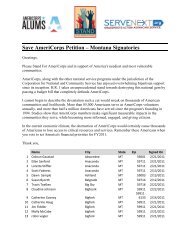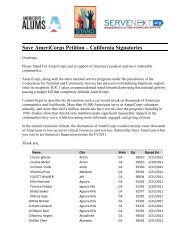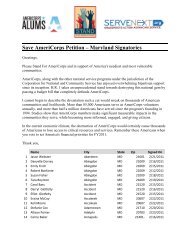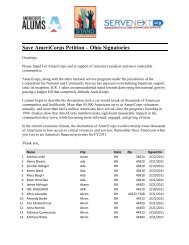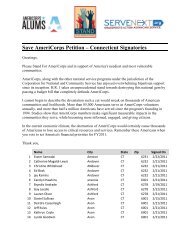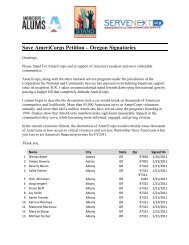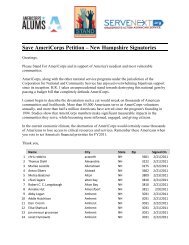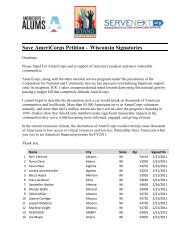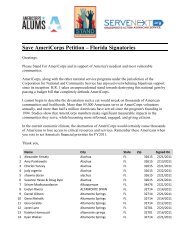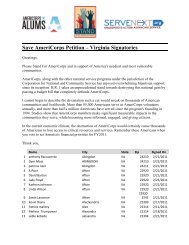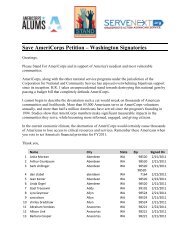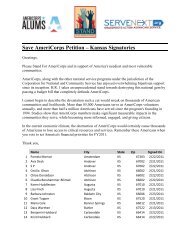love your block
love your block
love your block
You also want an ePaper? Increase the reach of your titles
YUMPU automatically turns print PDFs into web optimized ePapers that Google loves.
impact area: neighborhood revitalization<strong>love</strong> <strong>your</strong> <strong>block</strong>a service blueprintimpact areaneighborhoodrevitalizationLove Your Block is a tested, high-impact service strategy in which the Mayor’sOffice engages community members in revitalizing their neighborhoodsone <strong>block</strong> at a time. The City provides competitive grants to communitygroups to purchase the supplies needed for their local project andcoordinates City government services as needed to support the effort.The grants encourage community groups to identify priority projects anddevelop volunteer-fueled solutions. Common components of local projectsinclude vacant lot clean-up, litter removal, graffiti removal, tree planting,and community garden development. Common City government servicesprovided include pothole repair, replacing litter baskets, and speed bumpinstallation.
impact area: neighborhood revitalization
impact area: neighborhood revitalizationLOVE YOUR BLOCKLove Your Block is a tested, high-impact service strategy in which the Mayor’s officeengages community members in revitalizing their neighborhoods one <strong>block</strong> at atime. The City provides competitive grants to community groups to purchase thesupplies needed for their local project and coordinates City government services asneeded to support the effort. The grants encourage community groups to identifypriority projects and develop volunteer-fueled solutions. Common componentsof local projects include vacant lot clean-up, litter removal, graffiti removal, treeplanting, and community garden development. Common City government servicesprovided include pothole repair, replacing litter baskets, and speed bump installation.BACKGROUNDWell-tended public spaces create a better quality of life that attracts tax-paying businessesand residents to communities. Experts consider such spaces to be essential to creatingsustainable communities. Run down, litter-strewn spaces, however, signal lawlessness andlack of community spirit that can lead to crime and other negative behaviors. Engagedcommunities are far less likely to let their neighborhoods fall into poor conditions and canact as a powerful force in preventing crime.By providing small competitive grants and coordinating in-kind city services, the Mayor’soffice can achieve measurable impact in local communities and strengthen social capital atlittle cost.
impact area: neighborhood revitalizationBCDEREQUIRED ELEMENTSMayor’s office raises money to provide small grants to community groups for suppliesand coordinates with City agencies to identify a menu of services that cansupplement volunteer efforts at the neighborhood level.+Mayor’s office publicizes a grants competition soliciting proposals from communitygroups. Proposals must include a description of the challenges on the <strong>block</strong> and apreliminary work plan and basic budget that articulates how the grant would beused to address those challenges with volunteers.+Mayor’s office awards grants to community groups and coordinates City services asrequested by the grantees to support the local volunteer effort.+Mayor’s Office tracks and reports neighborhood revitalization impact metrics foreach project. Required metrics include:a. Number of <strong>block</strong>s (or other geographic unit, i.e. lots or neighborhoods) revitalized,AND at least two of the following:i. Square feet of graffiti removedii. Pounds of litter collectediii. Number of trees plantediv. Number of green spaces or community gardens createdb. Additional metrics may be tracked but are not required.EXECUTING LOVE YOUR BLOCKConducting a Grants Competition1. Develop a simple application process to solicit proposals from community groups. Theapplication should include information on the required impact metrics and the menuof City services that would be made available. Proposals must include a descriptionof the challenges on the <strong>block</strong> and a preliminary work plan and basic budget thatarticulates how the grant would be used to address those challenges with volunteers.
impact area: neighborhood revitalizationThey should also include “before” photos for reporting purposes. Applications canbe considered in cycles (typically four to six months) to allow for planning andcoordination of City services. (See resources section for a sample application fromNYC Service). If you are in a community where there is a HandsOn Network ActionCenter (www.HandsOnNetwork.org/ActionCenters) reach out to see if they will partnerto support the grant competition process.2. Advertise the grants competition broadly to ensure that all communities have access.Spreading the word via other local elected officials such as city council members can beparticularly useful. Community newspapers may also be interested in reporting on theopportunity for their readers in addition to using social media assets. Again, HandsOnAction Centers already have a great number of non-profit partners and could be greatpartners in advertising and advocating for local partners who would be great grantpartners.3. Select a slate of grant winners. Cities may find it useful to seek balance between projectsthat will require significant levels of agency resources or guidance and coaching fromthe department working with grant recipients and those that can operate with greaterself-sufficiency. Cities should also look for geographic diversity to ensure a broad reach.Working with Grant Recipients1. Conduct an initial orientation meeting for grant recipients (best times are after workhours or weekends). The orientation meeting is an opportunity to:a. Determine which in-kind City services could enhance the overall results of therevitalization project (if any).b. Explain impact reporting methods and expenditure and receipt trackingrequirements.2. Based on the availability of City services, work with Love Your Block grant recipientsto schedule project execution days and conduct pre-site visits with appropriateagency liaisons and project managers. This is also the ideal time to coordinate mayorparticipation, if any, in specific community projects and plan for press coverage ofcommunity projects.Coordinating City ServicesConsult with City agencies to develop a menu of in-kind City services that can be offeredto grantees to improve the physical conditions of <strong>block</strong>s. The City services are intended tocompliment the volunteer efforts, not replace them. Government provided services couldinclude:
impact area: neighborhood revitalization• Providing trash collection for <strong>block</strong> projects• Cleaning vacant lots• Creating new tree beds• Cleaning up illegal dumping• Repairing potholes• Replacing broken or worn-out litter baskets• Removing graffiti• Repairing damaged or missing streetsignage• Loaning gardening tools• Advertising projects to solicit additionalvolunteers• Repairing broken street lights• Installing speed humps or speed bumpsMeasuring ImpactCollecting data on the impact of each Love Your Block project is critical. In additionto reporting out on the number of <strong>block</strong>s (or other geographic unit, i.e. lots orneighborhoods) revitalized, each grant recipient must report on at least two of thefollowing metrics:• Square feet of graffiti removed• Amount of litter collected• Number of trees planted• Number of green spaces or community gardens createdCommunity groups should also submit “after” photos and report any additional metricsthat reflect their specific project as outlined in their work plan.Fundraising for Love Your BlockLove Your Block is a compelling fundraising opportunity for both foundations andcorporations with a commitment to <strong>your</strong> city or specific neighborhoods or communitieswithin <strong>your</strong> city. Local businesses, national corporations with local stores, or communityfoundations are all strong prospective funders for Love Your Block. Once you identify alist of possible funders, you can approach them in person or by phone, letter, or email. Inall cases, you will want to bring a short proposal that describes the opportunity for supportand how the funds will be used.The elements of a typical proposal include:• What is Love Your Block?• How will this initiative positively impact the community? (i.e., improvements inkey neighborhoods, increased community ownership of neighborhood spaces, moregreen spaces, increased safety)• Proposed breakdown of gift cards or mini-grants (i.e., 20 projects at $500 each)• The metrics that will be collected as a part of the initiative• Information on Cities of Service at the national level (this is especially helpful fornational organizations)• Recognition plan for the donor (this could include logos on t-shirts if <strong>your</strong> city iscreating them, branding on <strong>your</strong> service website if you have one, etc. ServiceNation
impact area: neighborhood revitalizationcan recognize donors on the national Service as a Strategy site as well, which issomething <strong>your</strong> city can offer to prospective sponsors)After the funds are distributed and the projects are complete, you will need to provide abrief thank you note and report to the donor. Typically, this report will include a list of theprojects completed, major successes and challenges, and any metrics collected from <strong>your</strong>partners. If you have before/after photos or any other still or video images of the project,include them with <strong>your</strong> thank you.In some cases, private funders may not want to provide funding directly to citygovernments. If that happens, you can either seek out a local non-profit partner to receivethe funds or contact ServiceNation who can also serve as a fiscal sponsor for the grant.OPTIONAL ELEMENTSome cities may choose to partner with a local nonprofit organization or a HandsOnNetwork Action Center in order to execute Love Your Block. In New York City, forexample, the Mayor’s office partners with Citizens Committee. Citizens Committee thenconducts the grant competition and works with grantees in coordination with the Mayor’soffice. In Atlanta, Hands On Atlanta is working closely with their Mayor’s office tosupport the execution of this initiative. An ideal nonprofit partner or HandsOn NetworkAction Center will have experience in organizing and advocacy work that engages ormobilizes citizens around revitalization projects or providing direct services.Provide opportunities for members of <strong>your</strong> community to participate in projects asindividuals or as a group. Engage volunteers, adopt neighborhoods and inspire others byexample. Potential responsibilities of a nonprofit partner could include:• Running the application process• Screening applications and preparing a slate of potential grant recipients.• Advertising grant application deadlines to neighborhood associations, civicorganizations, places of worship, nonprofit organizations• Making flyers and brochures and staffing tables at community events• Conducting site visits• Training or coaching grant recipients in effective project development, volunteermanagement• Collecting and synthesizing impact reports
impact area: neighborhood revitalizationHandsOn Action Centers can help with any of the above items and also have a clearunderstanding of the local non-profit sector. Some additional support a HandsOn ActionCenter could provide includes:• Help with identifying quality, well respected non-profits who would be great LoveYour Block applicants• Advertising Love Your Block to their non-profit partners and volunteers• Executing and/or enhancing Love Your Block projects by incorporating them intolarger scale projects, events or activities (such as Make A Difference Day, MLK Day,etc)• Additional volunteers to Love Your Block activities through their outreach andmarketing efforts.For more information about HandsOn Network Action Centers or to find at center nearyou visit www.handsonnetwork.org or www.HandsOnNetwork.org/ActionCenters.Recognize and Thank VolunteersVolunteer recognition is an extremely effective recruitment and retention tool. All ofus want to feel valued and appreciated, and it’s been proven that recognition is the bestand most productive means of doing so. Research conducted by Points of Light Instituteand HandsOn Network reveals that recognition not only motivates volunteers, but alsopromotes public awareness in local communities.We encourage you to recognize <strong>your</strong> outstanding volunteers by nominating and awardingthem with the President’s Volunteer Service Award or the Daily Point of Light Award.These are the highest and most prestigious volunteer awards directly associated with theWhite House and ones that all Americans can inspire to achieve. A display of recognitionwill not only leverage the nation’s focus on service, but also establish a direct link with <strong>your</strong>own community’s projects and activities and align <strong>your</strong> organization with a prestigiousnational award. Visit www.PresidentialServiceAwards.gov or www.PointsofLight.org formore information on how to recognize <strong>your</strong> volunteers.
impact area: neighborhood revitalizationLOVE YOUR BLOCK IN ACTIONLove Your Block was first implemented in New York City in 2009 as part of NYC Service,Mayor Bloomberg’s high-impact service plan. NYC Service partnered with CitizensCommittee, a local nonprofit, to revitalize 165 <strong>block</strong>s in the program’s first two grantcycles. Participating groups were awarded $500 grants to carry out their projects. As theprogram enters its third round, NYC Service has chosen to increase the grants to $1000and provide them to fewer organizations (50) to enhance impact. Below are some keylessons learned from the first year of implementation:• Plan to spend significant time synchronizing, scheduling and communicating withCity government agencies and volunteer groups.• Manage expectations. Failing to provide clear information on what services willbe provided by City government will leave resident groups feeling as though somepromises are unmet.• Launch an aggressive PR campaign to ensure broader participation fromunderrepresented areas. Reach out proactively to neighborhood groups, churches,community board meetings, community council meetings, libraries, local officials,etc.• Strike a good balance between groups that request city services and groups that planto do most of the work on their own.• Encourage and look for creativity among the project applications.• Translate applications into multiple languages.• Identify staffers who are available during nights and weekends (when neighborhoodgroups meet).RESOURCES• Find a volunteer opportunity in <strong>your</strong> community, go to HandsOnNetwork.org• Find a HandsOn Network Action Center to partner with at www.HandsOnNetwork.org/ActionCenters
impact area: neighborhood revitalizationSPECIAL THANKSWe’d like to thank the following partners for their support.
impact area: neighborhood revitalization
impact area: neighborhood revitalization | Love Your BlockService as a Strategy2 Canal ParkCambridge, Massachusetts 02141617-252-2703www.serviceasastrategy.org



